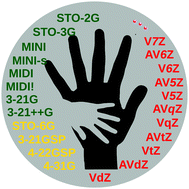CBS extrapolation of Hartree–Fock energy: Pople and Dunning basis sets hand-to-hand on the endeavour†
Abstract
The Hartree–Fock (HF) energy is shown to be extrapolatable from subminimal, minimal, and extended basis sets. Unprecedentedly, it can be reliably extrapolated to the complete basis set limit (CBS) from as small as Pople's STO-2G up to the largest aug-cc-pVXZ basis sets of Dunning's correlation-consistent type and even more complete variants of such ansatzes. The approach is tested on a panoply of small, medium and large molecular systems. As a case study, extrapolation is shown to be particularly reliable and cost-effective (typically an order of magnitude more economical for similar accuracy) when employing a hybrid (STO-2G,extended) basis set pair. The additional cost relative to a single-point calculation with the extended basis set is of no significance. After training the novel scheme with a meager set of 18 systems (TS-18), four test sets covering from neutrals (TS-105) to neutrals plus cations (TS-26) and anions (TS-17), these involving up to third-row elements, as well as tetrapeptide conformers (TS-10) were utilized for its validation. Although the answer to the question of whether all basis sets converge to the same HF/CBS limit is a clear yes, that of whether they show the same convergence rate is open, an issue also examined in the present work. For systems involving atoms up to the second-row of the periodic table the answer seems to be a clear yes, at least when using correlation-consistent basis sets, but it is shown to be a no when the study is extended to anionic systems containing third-row elements. For the latter, augmented correlation consistent basis sets display a faster, perhaps optimal, convergence rate. The implications of this in practice can hardly be anticipated. For example, it cannot be predicted a priori which of such basis sets will yield the best relative energies for those anions, although a logical expectation suggests it to be the augmented ones which turn out to display the fastest convergence. As a blind-test type illustration, the novel scheme is applied to the conformational analysis of 2 tetrapeptides with 5 conformers each, using from subminimal up to extended basis sets as large as cc-pV5Z and aug-cc-pVQZ. The (STO-2G,extended) results so obtained are predicted to be in very good agreement with the best data reported thus far.



 Please wait while we load your content...
Please wait while we load your content...